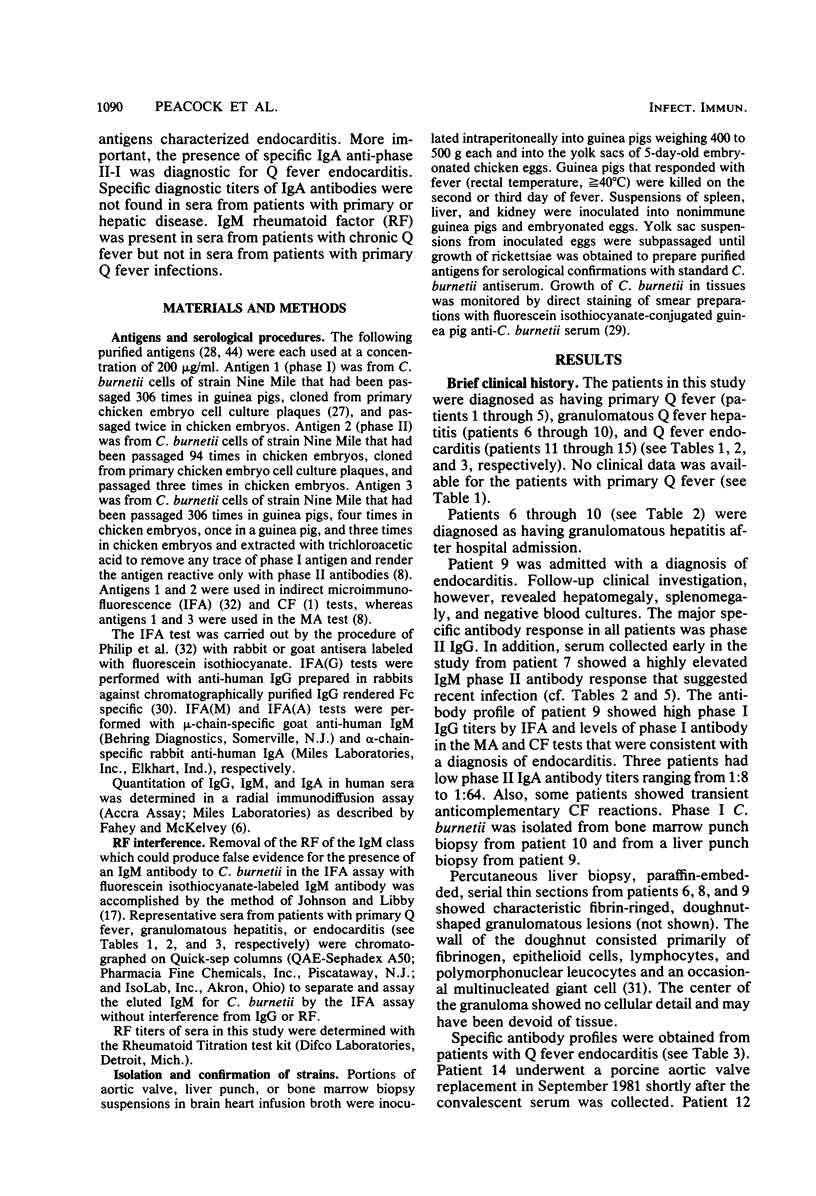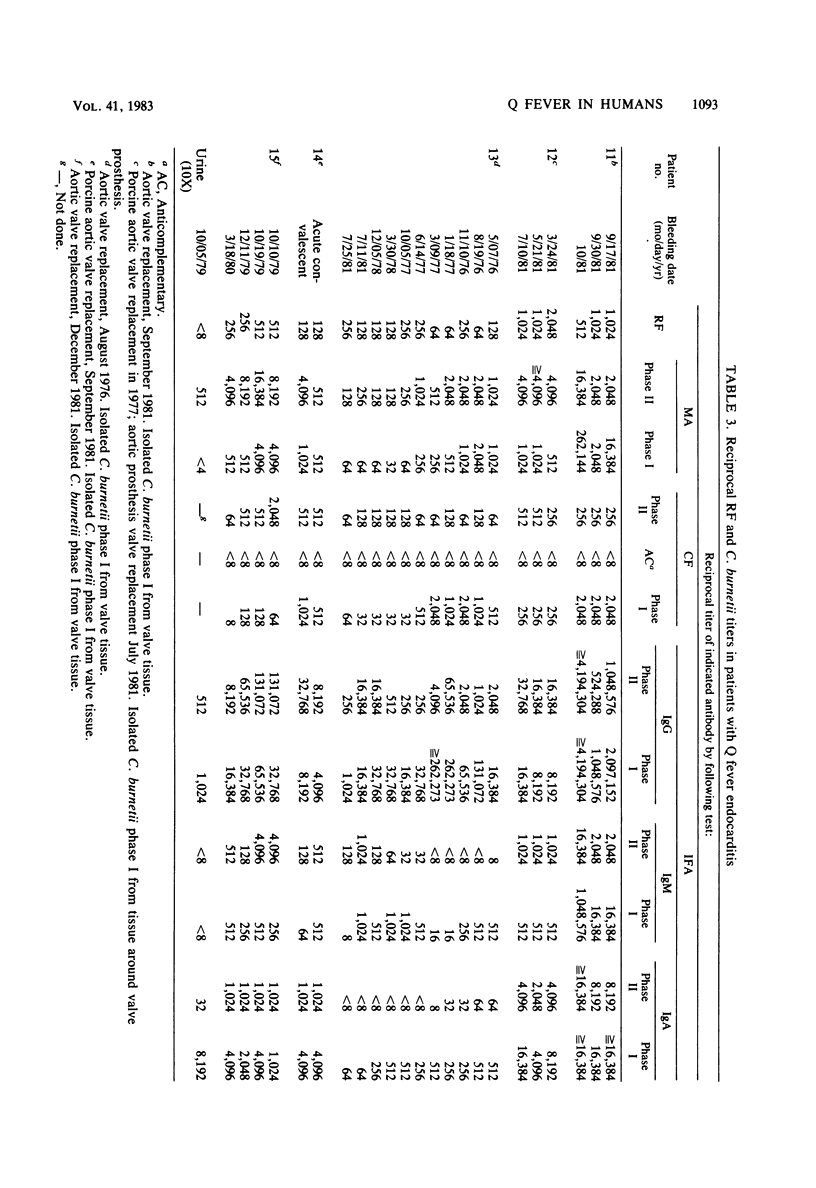Abstract
Serological parameters were compared in 15 cases of Coxiella burnetii infection comprising 5 cases each of primary Q fever, chronic granulomatous hepatitis, and endocarditis. The diagnosis was made on the basis of clinical history and serology and on the isolation of C. burnetii phase I from biopsy specimens of liver and bone marrow from two patients with granulomatous hepatitis and from the aortic valve vegetations of five patients with endocarditis. The temporal sequences of immunoglobulin levels, rheumatoid factor, and specific antibody responses to phase II and phase I antigens of C. burnetii were evaluated as predictive correlates of the three Q fever entities. Serum levels of immunoglobulin classes G, M, and A were variable in all the entities of Q fever. Increased mean levels (in milligrams per deciliter) of immunoglobulin G (IgG) and IgA were noted with chronic disease in the sera of some patients, whereas IgM levels were not significantly different from normal values. Rheumatoid factor was significantly elevated in chronic disease but not in primary Q fever. The temporal sequence of C. burnetii phase II and phase I antibodies were compared by microagglutination, complement fixation, and indirect microimmunofluorescence tests. All of these serological tests were useful in distinguishing primary from chronic disease. Thus, the ratio of anti-phase II to anti-phase I antibodies was greater than 1, greater than or equal to 1, and less than or equal to 1 for primary Q fever, granulomatous hepatitis, and Q fever endocarditis, respectively. Moreover, the high phase-specific IgA antibody titers in the indirect microimmunofluorescence test were diagnostic for endocarditis.
Full text
PDF









Selected References
These references are in PubMed. This may not be the complete list of references from this article.
- CLARK W. H., LENNETTE E. H., RAILSBACK O. C., ROMER M. S. Q fever in California. VII. Clinical features in one hundred eighty cases. AMA Arch Intern Med. 1951 Aug;88(2):155–167. doi: 10.1001/archinte.1951.03810080023003. [DOI] [PubMed] [Google Scholar]
- Cebra J. J., Emmons R., Gearhart P. J., Robertson S. M., Tseng J. Cellular parameters of the IgA response. Adv Exp Med Biol. 1978;107:19–28. doi: 10.1007/978-1-4684-3369-2_3. [DOI] [PubMed] [Google Scholar]
- Curet L. B., Paust J. C. Transmission of Q fever from experimental sheep to laboratory personnel. Am J Obstet Gynecol. 1972 Oct 15;114(4):566–568. doi: 10.1016/0002-9378(72)90222-0. [DOI] [PubMed] [Google Scholar]
- Delaney J. C., Roberts H. L. Q fever endocarditis and chronic liver involvement. Practitioner. 1975 Feb;214(1280):243–245. [PubMed] [Google Scholar]
- FAHEY J. L., MCKELVEY E. M. QUANTITATIVE DETERMINATION OF SERUM IMMUNOGLOBULINS IN ANTIBODY-AGAR PLATES. J Immunol. 1965 Jan;94:84–90. [PubMed] [Google Scholar]
- Fiset P., Ormsbee R. A., Silberman R., Peacock M., Spielman S. H. A microagglutination technique for detection and measurement of rickettsial antibodies. Acta Virol. 1969 Jan;13(1):60–66. [PubMed] [Google Scholar]
- Fiset P., Ormsbee R. A. The antibody response to antigens of Coxiella burneti. Zentralbl Bakteriol Orig. 1968 Apr;206(3):321–329. [PubMed] [Google Scholar]
- GIMENEZ D. F. STAINING RICKETTSIAE IN YOLK-SAC CULTURES. Stain Technol. 1964 May;39:135–140. doi: 10.3109/10520296409061219. [DOI] [PubMed] [Google Scholar]
- Hackstadt T., Williams J. C. Biochemical stratagem for obligate parasitism of eukaryotic cells by Coxiella burnetii. Proc Natl Acad Sci U S A. 1981 May;78(5):3240–3244. doi: 10.1073/pnas.78.5.3240. [DOI] [PMC free article] [PubMed] [Google Scholar]
- Hall C. J., Richmond S. J., Caul E. O., Pearce N. H., Silver I. A. Laboratory outbreak of Q fever acquired from sheep. Lancet. 1982 May 1;1(8279):1004–1006. doi: 10.1016/s0140-6736(82)92001-3. [DOI] [PubMed] [Google Scholar]
- Hinrichs D. J., Jerrells T. R. In vitro evaluation of immunity to Coxiella burnetii. J Immunol. 1976 Sep;117(3):996–1003. [PubMed] [Google Scholar]
- Hunt J. G., Field P. R., Murphy A. M. Immunoglobulin responses to Coxiella burnetii (Q fever): single-serum diagnosis of acute infection, using an immunofluorescence technique. Infect Immun. 1983 Feb;39(2):977–981. doi: 10.1128/iai.39.2.977-981.1983. [DOI] [PMC free article] [PubMed] [Google Scholar]
- Jerrells T. R., Mallavia L. P., Hinrichs D. J. Detection of long-term cellular immunity to Coxiella burneti as assayed by lymphocyte transformation. Infect Immun. 1975 Feb;11(2):280–286. doi: 10.1128/iai.11.2.280-286.1975. [DOI] [PMC free article] [PubMed] [Google Scholar]
- Johnson K. J., Ward P. A. Biology of disease. Newer concepts in the pathogenesis of immune complex-induced tissue injury. Lab Invest. 1982 Sep;47(3):218–226. [PubMed] [Google Scholar]
- Johnson R. B., Jr, Libby R. Separation of immunoglobulin M (IgM) essentially free of IgG from serum for use in systems requiring assay of IgM-type antibodies without interference from rheumatoid factor. J Clin Microbiol. 1980 Sep;12(3):451–454. doi: 10.1128/jcm.12.3.451-454.1980. [DOI] [PMC free article] [PubMed] [Google Scholar]
- Kazár J., Schramek S., Brezina R. Analýza sérových imunoglobulínov u pacientky s chronickou Q-horúckou a endokarditídou. Bratisl Lek Listy. 1977 Jan;67(1):109–114. [PubMed] [Google Scholar]
- LUOTO L., CASEY M. L., PICKENS E. G. Q FEVER STUDIES IN MONTANA. DETECTION OF ASYMPTOMATIC INFECTION AMONG RESIDENTS OF INFECTED DAIRY PREMISES. Am J Epidemiol. 1965 May;81:356–369. doi: 10.1093/oxfordjournals.aje.a120522. [DOI] [PubMed] [Google Scholar]
- Lumio J., Penttinen K., Pettersson T. Q fever in Finland: clinical, immunological and epidemiological findings. Scand J Infect Dis. 1981;13(1):17–21. doi: 10.1080/00365548.1981.11690361. [DOI] [PubMed] [Google Scholar]
- McCaul T. F., Williams J. C. Developmental cycle of Coxiella burnetii: structure and morphogenesis of vegetative and sporogenic differentiations. J Bacteriol. 1981 Sep;147(3):1063–1076. doi: 10.1128/jb.147.3.1063-1076.1981. [DOI] [PMC free article] [PubMed] [Google Scholar]
- Meiklejohn G., Reimer L. G., Graves P. S., Helmick C. Cryptic epidemic of Q fever in a medical school. J Infect Dis. 1981 Aug;144(2):107–113. doi: 10.1093/infdis/144.2.107. [DOI] [PubMed] [Google Scholar]
- Messner R. P., Laxdal T., Quie P. G., Williams R. C., Jr Rheumatoid factors in subacute bacterial endocarditis--bacterium, duration of disease or genetic predisposition? Ann Intern Med. 1968 Apr;68(4):746–756. doi: 10.7326/0003-4819-68-4-746. [DOI] [PubMed] [Google Scholar]
- Murphy A. M., Magro L. IgM globulin response in Q fever (Coxiella burneti) infections. Pathology. 1980 Jul;12(3):391–396. doi: 10.3109/00313028009077101. [DOI] [PubMed] [Google Scholar]
- Okun D. B., Sun N. C., Tanaka K. R. Bone marrow granulomas in Q fever. Am J Clin Pathol. 1979 Jan;71(1):117–121. doi: 10.1093/ajcp/71.1.117. [DOI] [PubMed] [Google Scholar]
- Ormsbee R., Peacock M., Philip R., Casper E., Plorde J., Gabre-Kidan T., Wright L. Serologic diagnosis of epidemic typhus fever. Am J Epidemiol. 1977 Mar;105(3):261–271. doi: 10.1093/oxfordjournals.aje.a112382. [DOI] [PubMed] [Google Scholar]
- POWELL O. W. Liver involvement in "Q" fever. Australas Ann Med. 1961 Feb;10:52–58. doi: 10.1111/imj.1961.10.1.52. [DOI] [PubMed] [Google Scholar]
- POWELL O. W., STALLMAN N. D. The incidence and significance of phase 1 complement-fixing antibody in Q fever. J Hyg (Lond) 1962 Sep;60:359–364. doi: 10.1017/s0022172400020477. [DOI] [PMC free article] [PubMed] [Google Scholar]
- Peacock M. G., Fiset P., Ormsbee R. A., Wisseman C. L., Jr Antibody response in man following a small intradermal inoculation with Coxiella burnetii phase I vaccine. Acta Virol. 1979 Jan;23(1):73–81. [PubMed] [Google Scholar]
- Peacock M., Burgdorfer W., Ormsbee R. A. Rapid fluorescent-antibody conjugation procedure. Infect Immun. 1971 Feb;3(2):355–357. doi: 10.1128/iai.3.2.355-357.1971. [DOI] [PMC free article] [PubMed] [Google Scholar]
- Pellegrin M., Delsol G., Auvergnat J. C., Familiades J., Faure H., Guiu M., Voigt J. J. Granulomatous hepatitis in Q fever. Hum Pathol. 1980 Jan;11(1):51–57. doi: 10.1016/s0046-8177(80)80105-5. [DOI] [PubMed] [Google Scholar]
- Philip R. N., Casper E. A., Ormsbee R. A., Peacock M. G., Burgdorfer W. Microimmunofluorescence test for the serological study of rocky mountain spotted fever and typhus. J Clin Microbiol. 1976 Jan;3(1):51–61. doi: 10.1128/jcm.3.1.51-61.1976. [DOI] [PMC free article] [PubMed] [Google Scholar]
- Rasmussen L., Kelsall D., Nelson R., Carney W., Hirsch M., Winston D., Preiksaitis J., Merigan T. C. Virus-specific IgG and IgM antibodies in normal and immunocompromised subjects infected with cytomegalovirus. J Infect Dis. 1982 Feb;145(2):191–199. doi: 10.1093/infdis/145.2.191. [DOI] [PubMed] [Google Scholar]
- Salonen E. M., Vaheri A., Suni J., Wager O. Rheumatoid factor in acute viral infections: interference with determination of IgM, IgG, and IgA antibodies in an enzyme immunoassay. J Infect Dis. 1980 Aug;142(2):250–255. doi: 10.1093/infdis/142.2.250. [DOI] [PubMed] [Google Scholar]
- Schachter J., Sung M., Meyer K. F. Potential danger of Q fever in a university hospital environment. J Infect Dis. 1971 Mar;123(3):301–304. doi: 10.1093/infdis/123.3.301. [DOI] [PubMed] [Google Scholar]
- Spicer A. J. Investigation of Coxiella burneti infection as a possible cause of chronic liver disease in man. Trans R Soc Trop Med Hyg. 1979;73(4):415–417. doi: 10.1016/0035-9203(79)90166-4. [DOI] [PubMed] [Google Scholar]
- Tobin M. J., Cahill N., Gearty G., Maurer B., Blake S., Daly K., Hone R. Q fever endocarditis. Am J Med. 1982 Mar;72(3):396–400. doi: 10.1016/0002-9343(82)90495-8. [DOI] [PubMed] [Google Scholar]
- Tokarevich N. K., Zhebrun A. V., Khazenson S. L., Roshchina N. G. Determination of immunoglobulin classes of antibodies against Coxiella burnetii by protein A from Staphylococcus aureus. Acta Virol. 1980 May;24(3):218–221. [PubMed] [Google Scholar]
- Turck W. P., Howitt G., Turnberg L. A., Fox H., Longson M., Matthews M. B., Das Gupta R. Chronic Q fever. Q J Med. 1976 Apr;45(178):193–217. [PubMed] [Google Scholar]
- Williams J. C., Peacock M. G., McCaul T. F. Immunological and biological characterization of Coxiella burnetii, phases I and II, separated from host components. Infect Immun. 1981 May;32(2):840–851. doi: 10.1128/iai.32.2.840-851.1981. [DOI] [PMC free article] [PubMed] [Google Scholar]
- Wilson H. G., Neilson G. H., Galea E. G., Stafford G., O'Brien M. F. Q fever endocarditis in Queensland. Circulation. 1976 Apr;53(4):680–684. doi: 10.1161/01.cir.53.4.680. [DOI] [PubMed] [Google Scholar]
- Wisniewski H. J., Kleiman M. M., Lackman D. B., Krumbiegel E. R. Demonstration of inapparent infection with disease agents common to animals and man. Health Lab Sci. 1969 Jul;6(3):173–177. [PubMed] [Google Scholar]


